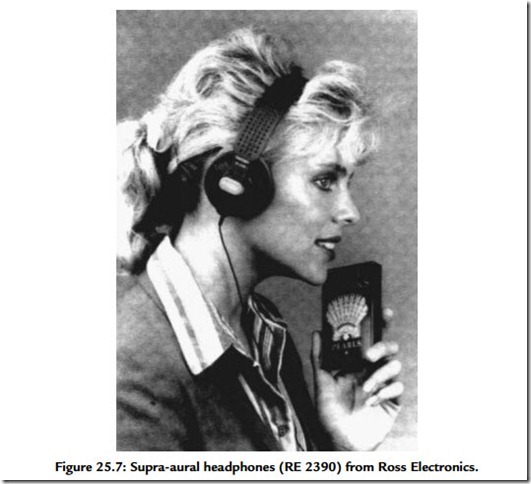Basic Headphone Types
Apart from the many different operating principles described earlier, there are two basic categories into which headphones will fall, although some designs will include features of both and will therefore not function purely as one type or the other.
Velocity
The open or free-air headphone, known as the velocity type, sits just away from the ear flap, often resting on a pad of light, acoustically transparent reticulated foam. This type of headphone cannot exclude outside sounds, which can intrude on the reproduced music, but the best models can produce a very light, open, airy sound. This type of headphone has been very successful in recent years, particularly since the growth in personal stereos—“Walkman” clones—where their light weight and compact dimensions have made them ideal.
A theoretically perfectly-stiff diaphragm operating in free air, like a velocity headphone, has a frequency response that falls away at low frequencies at 6 dB per octave and so you would expect the system not to work particularly well. However, by juggling with the parameters of mechanical diaphragm stiffness, mass, and acoustic damping, it is possible to get a perfectly adequate low-frequency performance from velocity headphones, which is not dependent on the exact position of the headphones on the ears. The rear face of
the diaphragm in velocity headphones is essentially open to the air, which helps impart a more open airy sound, but does not exclude outside noises.
Pressure
The other category is the closed or circumaural headphone, known as the pressure type, which totally encloses the ear flap and seals around it with a soft ear cup. The principal advantages of this type of headphone are that sealing around the ear makes it possible to pressure couple the diaphragm to the ear drum from about 700 Hz down to very low frequencies, with a linear response down to 20 Hz easily achievable, as long as the seal is effective (Figure 25.7). The frequency response of the pressure type, unlike the velocity type, is essentially flat down to a low frequency, which is dependent only on the degree of sealing. A poor seal due to inadequate headband pressure, or the wearing of spectacles, for instance, can cause a marked deep bass loss.
The principal disadvantages are that closed headsets tend to be heavier, require greater headband pressure, and can make the ears hot and uncomfortable. Pressure-type headphones can be either closed backed or open backed. Closed-backed headphones offer the exclusion of outside sounds as a distinct advantage in situations that require this, such as recording studios, for instance. However, there is a body of opinion that judges the sound of closed-back headphones to be closed-in compared to open-backed types.
Intra-Aural
Another category that has been recently commercialized is the intra-aural type, which actually fits into the ear to provide very lightweight personal listening (Figure 25.8). Obviously the transducer size limits the bass performance, although this is helped by channeling the sound almost directly into the ear canal.
